Sphinginae subfamily
Sphingini tribe:
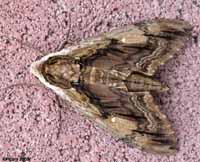 |
Ceratomia amyntor,
the Elm Sphinx or Four-horned Sphinx:
Upperside of forewing is brown with dark brown and white
markings including a white costal area near wing base, dark
streaks along veins, and a white spot in cell. Upperside
of hindwing is light brown and has dark brown band along
outer margin.
Larvae feed on Elm (Ulmus), birch (Betula), basswood (Tilia), and
cherry (Prunus).
|
 |
Ceratomia undulosa, the Waved
Sphinx:
The upperside of the forewing is pale brownish gray with wavy black
and white lines and a black-outlined white cell spot. The upperside
of the hindwing is gray with diffuse darker bands.
|
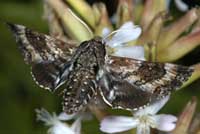 |
Dolba hyloeus, the Pawpaw Sphinx
The upperside of the forewing is dark brown with a dusting of white
scales. Some moths have patches of
reddish or yellowish brown on the wings.
Larve are not limited to pawpaw.
|
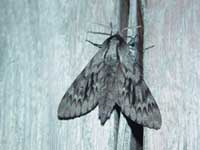 |
The upperside of the forewing is gray with heavy black bands. The
upperside of the hindwing is brownish gray with no markings.
|
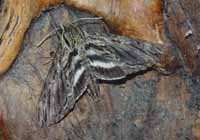 |
Lintneria eremitus,
the Hermit Sphinx:
The upperside of the forewing is gray-brown with wavy lines, black
dashes, and one or two small white spots near the center of the
costa. The upperside of the hindwing is black with two white bands
and a triangular black patch at the base.
Note the golden hair on the thorax.
|
 |
Manduca quinquemaculatus, the Five-spotted Hawkmoth:
The moth abdomen usually has five, sometimes six pairs of yellow
bands. The upperside of the forewing is blurry brown and gray. The
upperside of the hindwing is banded with brown and white and
has two well-separated median zigzag bands.
|
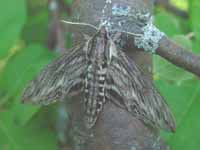
|
Sphinx canadensis,
Sphinx canadensis, the Canadian Sphinx, is not common, and is not
often reported anywhere,
but it may be in Franklin County.
Larval hosts are white ash (Fraxinus americana) and blueberry
(Vaccinium).
|
 |
Sphinx chersis, the Northern Ash Sphinx or Great Ash
Sphinx: Upperside of forewing is soft dark gray to blue-gray with
a series of black dashes, one of which reaches wing tip.
Upperside of hindwing is black with blurry pale gray bands.
Larval hosts are ash, lilac, privet, cherry, and quaking aspen.
|
 |
Forewings, long and slender, are held close to the body when the moth
is at rest.
|
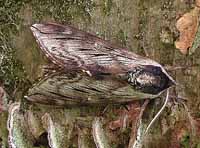 |
Colouration and markings are highly variable from one specimen to
another. The fringes on forewing are mostly
black with some white; those on the hindwing are mostly white with a
few black patches.
|
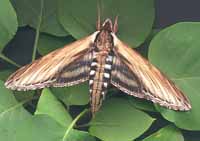 |
The lower forewings are predominantly brownish-yellow with a fairly
wide dark bar along the inner margin. At rest the wings hug
the body, giving the moth a long slender look.
|
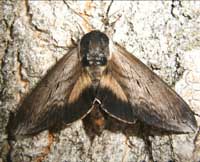 |
Sphinx luscitiosa ,
the Canadian Sphinx or
Clemen's Sphinx:
Fw upperside is yellowish gray in males and pale
gray with faint yellow tint in females. Dark
border on outer margin widens as it approaches inner margin.
Hw upperside is deep yellow in males, pale yellow in
females; both with a wide black border.
|
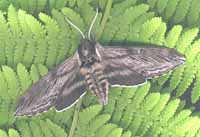 |
Sphinx poecila, the Poecila Sphinx:
FW outer wing fringes are checkered black and white;
almost pure white (lightly checked with grey) on
hw. Dark gray fw has diffuse black and gray wavy
lines with series of black dashes ending at wing tip, and a
white cell spot. Cell spot readily distinguishes poecila
from canadensis.
|
Smerinthini Tribe:
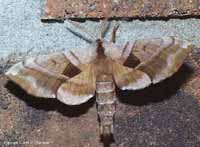 |
Amorpha juglandis,
the Walnut Sphinx:
Adults are highly variable; sometimes wings of an individual
may be all one color or may have several colors, ranging from pale to
dark brown, and may have a white or pink tinge. Patterns range from
faint to pronounced.
This is first Sphinx species I reared as a boy in New Jersey.
See file for female; she is different.
|
 |
This large moth has a full, heavy body, and females can be remarkably
plump.
|
 |
Paonias excaecata, the Blinded Sphinx:
Outer margin of forewing is quite wavy. There is a dark cell
spot and a dark oblique line mid wing from costa almost to
inner margin. Basic ground colour is pinkish brown.
At rest lower wings are almost completely hidden.
Moth gets its name from blue-gray pupil surrounded by black,
with hot pink wing scales in basal area of hindwing.
|
 |
Named for the small eye-spot in the hindwing, this moth has a
wide distribution
and is probably common in Franklin County although not officially
recorded.
I regularly see them on Prince Edward Island, and they are reported
as far south as Florida.
|
 |
Smerinthus cerisyi, the Cerisyi's Sphinx:
Degree of scalloping in fw outer margin is highly variable.
Specimens from Canadian Prairie provinces tend to be darker than
specimens from elsewhere. Circular or diamond-shaped black spot
of hindwing is usually centered in blue spot.
|
 |
Smerinthus jamaicensis, the Twin-spotted Sphinx
Smerinthus jamaicensis closely resembles Smerinthus cerisyi, but
jamaicensis is much smaller with larger blue patches on more vibrant
and deeper purple in the lower wings. Look for dark brown half moon,
inwardly banded in white, at forewing apex.
|
Macroglossinae subfamily
Dilophonotini tribe:
See Hemaris comparison to help
distinguish the next three species.
 |
Hemaris diffinis, the Snowberry Clearwing or Bumblebee
Moth
Hemaris diffinis is a very variable species, but almost always the
abdomen sports contrasting black and yellow hairs, the ventral
surface being quite black. The legs also tend to be quite dark and
there is a black mask running across the eye and along the sides of
the thorax.
|
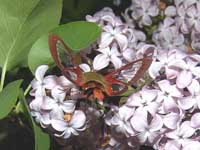 |
Hemaris gracilis, the
Slender Clearwing or Graceful Clearwing
Hemaris gracilis is distinguished from similar species by a pair of
red-brown bands on the undersides of the thorax, which varies from
green to yellow-green dorsally and sometimes brown with white
underneath. They have a red abdomen.
|
 |
It is not difficult to see why many gardeners would mistake an
Hemaris thysbe moth for a small hummingbird as it hovers, sipping
nectar from flowers through a long feeding tube.
|
Philampelini tribe:
 |
Adults nectar from flowers of Japanese honeysuckle
(Lonicera japonica), petunia (Petunia hybrida), mock orange
(Philadelphus coronarius), and phlox (Phlox). unlikely
|
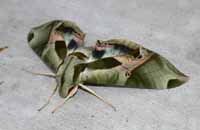 |
If you have Grape or Virginia Creeper nearby, then you probably have
this species.
I often get asked to identify larvae from areas where they have not
previously been reported.
|
Macroglossini tribe:
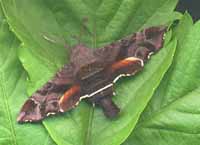 |
This day flier is widely distributed. If you have Virginia Creeper,
you probably have the Nessus Sphinx.
Two bright, distinct,
narrow yellow bands are often visible on the abdomen.
Posed specimen, left, only shows one yellow abdominal band.
|
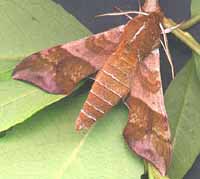 |
They are common in New Jersey and common
here on Prince Edward Island.
You will often see this species listed as Darapsa pholus,
especially in older literature. The lower wings of this hawkmoth are
a solid brownish-orange, matching the body colour.
|
 |
Darapsa myron, the Virginia Creeper Sphinx or the
Grapevine Sphinx
The forewing upperside is dark brown to pale yellowish gray/green,
with an olive tint. On the costal margin there is a dark rectangular
patch, although this may be reduced or absent. The upperside of the
hindwing is pale orange.
|
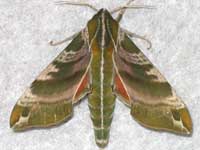 |
Darapsa versicolor,
the Hydrangea Sphinx:
Fw upperside is often greenish brown with
curved dark lines and pinkish-white patches.
Hw upperside is pale yellow to reddish brown with white
along the costal margin, greenish brown along the outer margin, and
white shaded with greenish brown on inner margin.
|
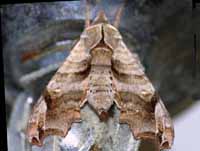 |
The moth's outer margin of the forewing is deeply scalloped.
The upperside is light brown with dark brown markings.
There is a small black and white spot near the tip.
The upperside of the hindwing is orange-brown with a dark brown outer margin and median line.
|
 |
Hyles gallii, the Bedstraw Hawk Moth
or Gallium Sphinx
This moth is somewhat similar to the White-lined Sphinx, but has a
broader, more irregular cream coloured oblique line, and it lacks
the smaller white lines on the forewing. Thorax is also without white lines.
|
 |
Hyles lineata, the White-lined Sphinx
The forewing upperside is dark olive brown with paler brown along the
costa and outer margin, a narrow tan band running from the wing tip
to the base, and white streaks along the veins.
The hindwing upperside is black with a reddish pink median band.
|
 |
Proserpinus flavofasciata, the Yellow-banded Day Sphinx
This species is not officialy reported from Franklin County.
Adults fly as a single brood from April-June in meadows in coniferous
forests. Adults fly during the afternoon.
|
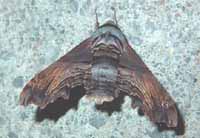 |
Adults are said to mimic bumblebees and make a buzzing sound when
feeding. The wing margins are scalloped. The upperside of the
forewing is dark brown with light brown bands and markings. The
upperside of the hindwing is yellow with a wide black outer margin.
|
|
|
